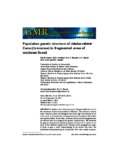Por favor, use este identificador para citar o enlazar este ítem:
http://www.alice.cnptia.embrapa.br/alice/handle/doc/1019672Registro completo de metadatos
| Campo DC | Valor | Lengua/Idioma |
|---|---|---|
| dc.contributor.author | SANTOS, R. R. M. | pt_BR |
| dc.contributor.author | CAVALLARI, M. M. | pt_BR |
| dc.contributor.author | PIMENTA, M. A. S. | pt_BR |
| dc.contributor.author | ABREU, A. G. de | pt_BR |
| dc.contributor.author | COSTA, M. R. | pt_BR |
| dc.contributor.author | GUEDES, M. L. | pt_BR |
| dc.date.accessioned | 2015-07-13T11:11:11Z | pt_BR |
| dc.date.available | 2015-07-13T11:11:11Z | pt_BR |
| dc.date.created | 2015-07-13 | pt_BR |
| dc.date.issued | 2015 | pt_BR |
| dc.identifier.citation | Genetics and Molecular Research, v.14, n. 2, p. 6472-6481, 2015. | pt_BR |
| dc.identifier.uri | http://www.alice.cnptia.embrapa.br/alice/handle/doc/1019672 | pt_BR |
| dc.description | Attalea vitrivir Zona (synonym Orbignya oleifera) is one of the six species of Arecaceae known as ?babassu?. This species is used to make cosmetics, food, and detergents due to the high concentration of oil in the seeds. It is found only in fragmented areas of southern Bahia State and northern Minas Gerais State, southeast Brazil, and this fragmentation has affected both its ecological and genetic characteristics. We evaluated the genetic diversity and population genetic structure of A. vitrivir in six areas of two different regions at the extremes of its geographical range, in order to gain a better understanding of the factors that affect the distribution and partitioning of its diversity. Nine inter simple sequence repeat (ISSR) markers amplified 74 polymorphic bands, resulting in large diversity values (Shannon diversity index, 0.37-0.47; intrapopulation genetic diversity, 0.25-0.34). Analysis of molecular variance (AMOVA) revealed considerable differentiation between sampling sites (30.03%) and regions (12.08%), although most of the diversity was observed within sampling sites (69%). Further differentiation between sampling sites was noted more in the northern region than in the southern region, highlighting the genetic connectivity between the sampling sites within Rio Pandeiros Environmental Protection Area (southern region). The identification of two distinct genetic clusters (K = 2) corresponded to the northern and southern regions, and corroborated the AMOVA results. We suggest that the northern area, outside Rio Pandeiros Environmental Protection Area, must be included in future management plans for this species. | pt_BR |
| dc.language.iso | eng | eng |
| dc.rights | openAccess | eng |
| dc.subject | Fragmentação regional do babaçu | pt_BR |
| dc.subject | Estrutura genética | pt_BR |
| dc.subject | Diversidade genética | pt_BR |
| dc.subject | Attalea vitrivir | pt_BR |
| dc.subject | Babassu | pt_BR |
| dc.subject | Orbignya oleifera | pt_BR |
| dc.title | Population genetic structure of Attalea vitrivir Zona (Arecaceae) in fragmented areas of southeast Brazil. | pt_BR |
| dc.type | Artigo de periódico | pt_BR |
| dc.date.updated | 2018-02-27T11:11:11Z | pt_BR |
| dc.subject.thesagro | Babaçu | pt_BR |
| dc.subject.thesagro | Cerrado | pt_BR |
| dc.subject.nalthesaurus | Habitat fragmentation | pt_BR |
| dc.subject.nalthesaurus | Arecaceae | pt_BR |
| dc.format.extent2 | 10 p. | pt_BR |
| riaa.ainfo.id | 1019672 | pt_BR |
| riaa.ainfo.lastupdate | 2018-02-27 -03:00:00 | pt_BR |
| dc.identifier.doi | http://dx.doi.org/10.4238/2015.June.11.23 | pt_BR |
| dc.contributor.institution | UNIMONTES; MARCELO MATTOS CAVALLARI, CPACP; UNIMONTES; ALUANA GONCALVES DE ABREU, CNPAF; UFVJM; UNIMONTES. | pt_BR |
| Aparece en las colecciones: | Artigo em periódico indexado (CPACP)  | |
Ficheros en este ítem:
| Fichero | Descripción | Tamaño | Formato | |
|---|---|---|---|---|
| gmr5455.pdf | 745,56 kB | Adobe PDF |  Visualizar/Abrir |









